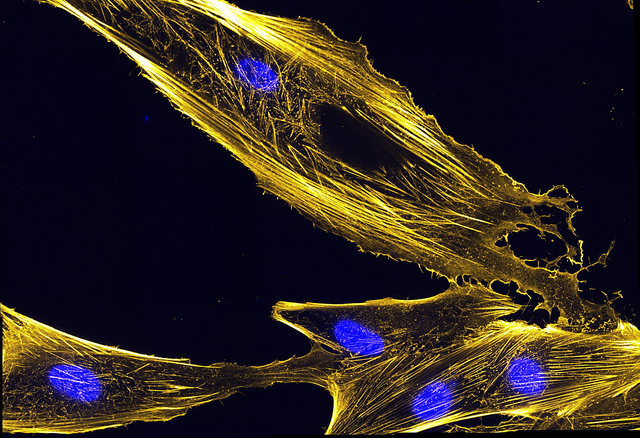In science, it’s difficult to predict where the next discovery will emerge. While researchers hope that their grant-funded research will be fruitful, sometimes impactful findings can arise from seemingly unlikely source—which is what investigators at the Woods Hole Marine Biological Laboratory (MBL) recently encountered. Two new studies, which began as a student project in the MBL Physiology Course and were developed in the MBL Whitman Center, show how cells respond to internal forces when they orient, gain traction, and migrate in a specific direction.
The findings from the new studies were published recently in Proceedings of the National Academy of Sciences (PNAS), in an article entitled “Actin Retrograde Flow Actively Aligns and Orients Ligand-Engaged Integrins in Focal Adhesions,” and Nature Communications, in an article entitled “Direction of Actin Flow Dictates Integrin LFA-1 Orientation during Leukocyte Migration.”
Both papers focused on the activation of integrins—proteins that allow cells to attach to their external environment and respond to signals coming from other cells. Integrins are transmembrane proteins that often conduct extracellular signals internally, causing structural proteins to react in numerous ways. Using the microscope invented at the MBL, the researchers showed that when integrins unfurl from the cell surface and bind extracellularly, they simultaneously align in the same direction as a force inside the cell (actin retrograde flow).
Alignment of integrins (red is more aligned) during migration of a Jurkat T-cell. [Nordenfelt et al., Nature Communications, December 11, 2017.]
“If you think of a cell as a car, the actin flow is the engine,” explained senior investigator on both studies Clare Waterman, Ph.D., a Whitman Center scientist from the National Heart, Lung, and Blood Institute at the NIH. “The cell can sit there, idling its engine. But when the integrins activate and bind externally, they are like the tires hitting the road, providing friction. The engine goes into gear and the car moves.”
The research team used a fluorescence polarized light microscope developed at MBL to measure—in real time and with high precision—the orientation of the integrins on the cell surface.
![Representative total fluorescence intensity image of aL-T Jurkat T cell migrating on intercellular adhesion molecule 1 (ICAM-1) (10 µg/mL) with overlay of regions of interest (white, leading edge; magenta, cell body), normal to leading edge tangent (yellow), and average green fluorescent protein (GFP) emission dipole orientation with length proportional to polarization factor (red). Scale bars, 1 µm. Panel below is enlarged from dashed area. [Nordenfelt et al., Nature Communications, December 11, 2017, Fig. 5b]](https://genengnews.com/wp-content/uploads/2018/08/158168_web7923310819-1.jpg)
Representative total fluorescence intensity image of aL-T Jurkat T cell migrating on intercellular adhesion molecule 1 (ICAM-1) (10 µg/mL) with overlay of regions of interest (white, leading edge; magenta, cell body), normal to leading edge tangent (yellow), and average green fluorescent protein (GFP) emission dipole orientation with length proportional to polarization factor (red). Scale bars, 1 µm. Panel below is enlarged from dashed area. [Nordenfelt et al., Nature Communications, December 11, 2017, Fig. 5b]
“It's quite remarkable that you can do that with a microscope,” noted co-senior investigator on both studies Timothy Springer, Ph.D., professor of biological chemistry, molecular pharmacology, and medicine, at Harvard Medical School, who also co-discovered the integrin family of proteins in the 1980s. “I don't know of any other examples where people have actually measured the orientation of a cell-surface molecule.”
There are 24 different types of integrins found on human cells. In the PNAS paper, the research team studied an integrin on fibroblast cells, while the Nature Communications paper analyzed an integrin on leukocytes.
“The two integrins we worked on were about as structurally different as you can get in the integrin family,” Dr. Springer remarked. However, both types, when activated, oriented in a direction dictated by intracellular actin flow.
Dr. Springer concluded, stating that “this is really beautiful basic research. While we knew a lot about highly purified integrins in solution, this research gives us specific information about their activation state in living cells.”







